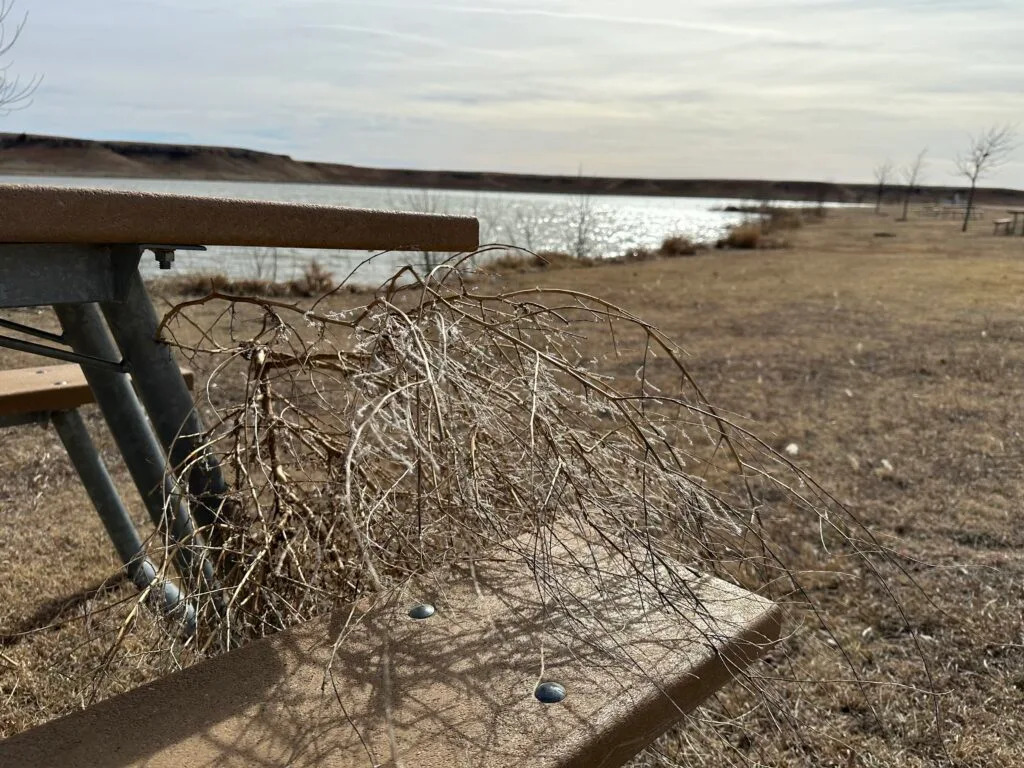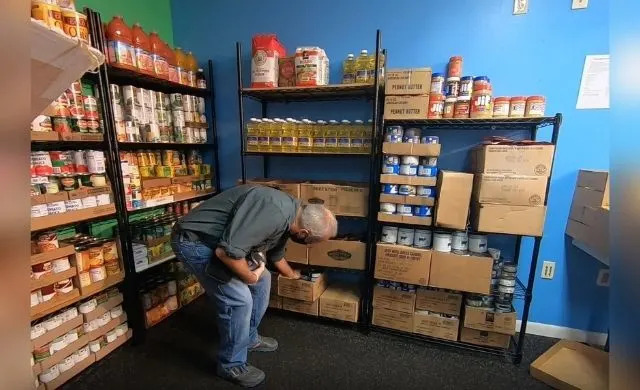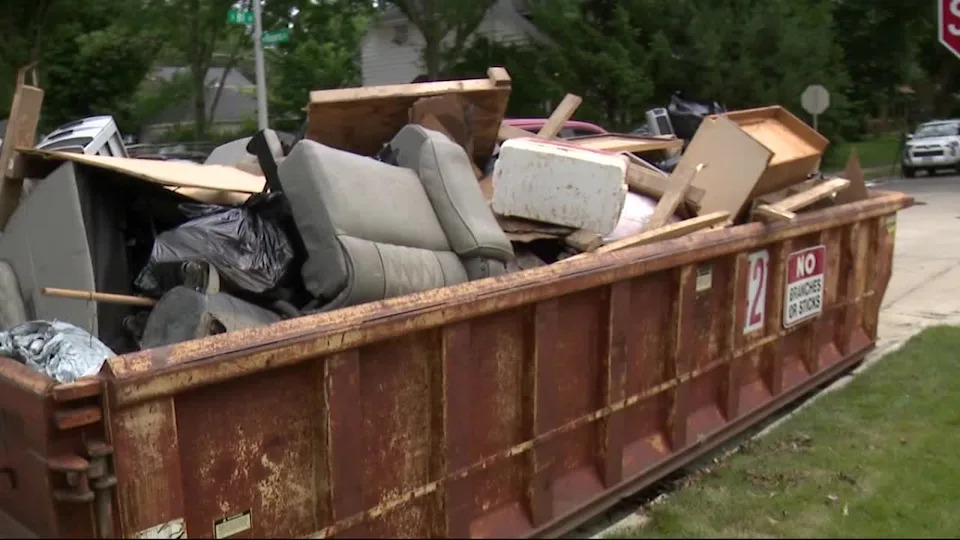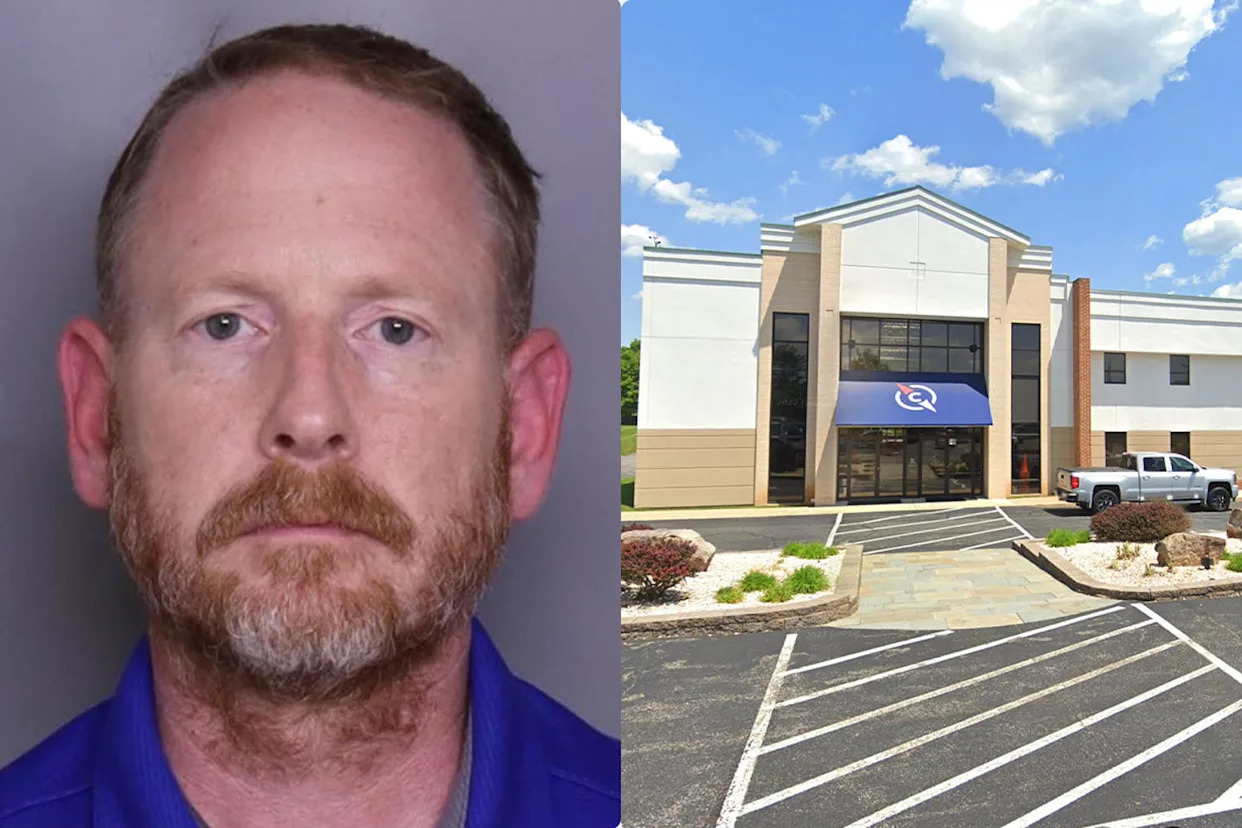
A tumbleweed clings to a picnic table at HorseThief Reservoir, which was constructed for flood control, and at times is reduced to a "puddle" due to required release of water to satisfy downstream water rights, said Randy Still, general manager of the Pawnee County watershed. He says the reservoir has met flood management expectations, but future releases should be reduced to protect the investment. (AJ Dome for Kansas Reflector)
TOPEKA — The 186 residents of Pawnee Rock want clean water to flow from kitchen faucets, but uranium contamination forced one city well to be taken offline and meant the western Kansas community was down to a single well.
“No redundancy,” said Katie Miller, director of water resources with Kansas Municipal Utilities, an association working on behalf of more than 200 communities. “No backup.”
She told members of the Kansas Water Program Task Force on Monday the solution in Pawnee Rock was to earmark $4.1 million for a new source of water that hopefully would be adequate in supply and quality.
Uranium may be a surprising impediment to operation of a healthy water system, but consequences of Kansas’ overreliance on irrigation for crops, and pollution of surface and groundwater with nitrates prominent in agricultural runoff, made it difficult to guarantee a lasting supply for the 3 million residents of Kansas.
“Nitrates are impacting so many of our utilities,” said Miller, who argued solutions had to be found. “We don’t have a choice from a public health standpoint.”
Cities, counties, the state and a Kansas network of groundwater districts struggle with issues of supply and demand, economic and legal complexities, workforce development, shifting government regulation and unpredictable costs of infrastructure projects while attempting to shape current practices to solidify the water future of Kansas.
The cost of water treatment plants or pipeline projects could easily double or triple in the time required to move from planning to operation.
In the city of Anthony in Harper County, there’s trouble with the $6 million water plant and nine-mile waterline connecting fresh water to 2,000 residents. The project completed in 2016 with a U.S. Department of Agriculture loan became controversial when the pipeline began experiencing frequent cracks running down the spine of piping. Repairs of the fractures cost $275,000 to $350,000 annually, so Miller said the logical remedy was to replace the defective pipe.
She said the problem with installing a new waterline was the estimated cost of $22 million to $32 million.
“We’re looking at a massive waterline project,” Miller said.

Like gold
Harold Nolte, president of Dodge City Community College, set the table for Miller’s assessment and the task force’s broader conversation about the future of water.
“Water is like gold,” Nolte said. “It’s very valuable.”
The task force learned Kansas’ groundwater management districts have been instructed to identify problems and solutions to regional water issues by a July 2026 deadline established in state law.
Orrin Feril, who represents Big Bend Groundwater Management District No. 5, said the district struggled more with water quality than water quantity. The region of Rattlesnake Creek, which is a tributary to the Arkansas River in central Kansas, had resisted attempts to reverse impairments recognized more than a decade ago, he said.
“We’ve tried many different plans. Some successful, some not. Mostly in the latter category,” Feril said. “What we’re dealing with are activities that happened in the past that have impacted the groundwater.”
Rep. Lindsay Vaughn, an Overland Park Democrat serving on the task force, suggested farmers, ranchers and other consumers ought to aggressively pursue water conservation as a self-preservation strategy. She recommended offering incentives to reduce field applications that contributed to nitrate runoff harmful to water resources.
The idea of the Legislature directing groundwater district boards to track application of nitrates may be worthy of consideration, said Sen. Kenny Titus, R-Manhattan.
“Do you think we should be looking at requiring groundwater management districts to more actively manage nitrates and farming practices?” Titus asked Feril.
Historically, Kansas officials have leaned into collaborative reform rather than mandated change to extend life of the Ogallala Aquifer, support dwindling streams and creeks or protect government investments in reservoirs.
“I don’t know how to answer that question,” Feril said. “We have regulatory authority to impose requirements for sampling. The board at this point has taken a different track. They said, ‘Let’s not take that heavy-handed approach. Let’s do it in a voluntary method.’ ”
Jason Norquest, assistant general manager of the Groundwater Management District No. 3, said part of his quest was to develop support from heavy water users for new strategies for extending the life of water resources. In some areas aquifer consumption should fall by as much as 25% over the next couple decades, he said.
Economic consequences of moving closer to a sustainable supply, or better matching the volume of water going in and coming out of the ground, cannot be dismissed by politicians or regulators, he said.






Comments